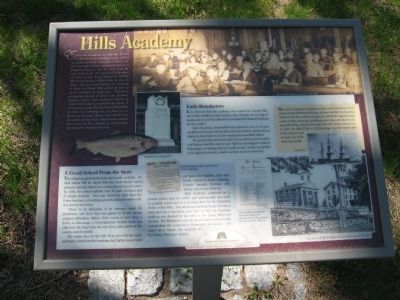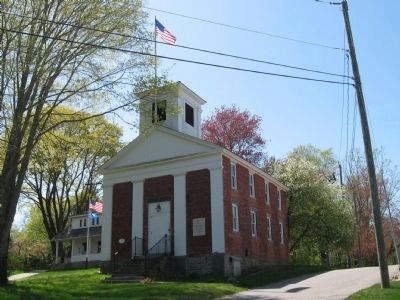Essex Village in Middlesex County, Connecticut — The American Northeast (New England)
Hills Academy
Essex was beginning to come into its own in 1832 when this building, known as Hills Academy, was built. Twelve years before, the new Borough of Essex, previously known as Potapoug Quarter, was set apart from the town of Saybrook. A letter dated September 24, 1831, in the Essex Historical Society files from Captain Gideon Parker to his son states, “We are about building our Academy at Essex on Pound Hill – expect to have it set for operation in April next.” Seventeen prominent citizens of Essex, one of them, Captain Parker, had purchased shares of stock at $25 a share to establish the school. A charter was granted by the General Assembly in 1833. The building site, on what is now known as Prospect Street, was carved from the lands of John Pratt, whose house around the corner on West Avenue is owned today by the Essex Historical Society.
A Co-ed School From the Start
The school accepted both male and female students. An 1834 tuition bill for Sarah Post has been found, which indicates that the school was coeducational from the start. By 1846, the school bulletin lists 34 male students and 47 female students. This ratio shifted in 1848 when the Essex Seminary, a boarding school building for males only was erected next door.
There is no indiation of an entrance exam for admittance and there does not appear to be any strong religious affiliation. Rather, there seems to have been a desire to encourage a heterogeneous student body, not only from the local area but also from other parts of the country and the world.
The tuition fees for the Fall Term were $50 for room and board, which included washing, fuel, lights, supervision and tuition for English, Latin, and Greek, Classes in music, painting, French, Spanish, German, and Italian required an extra fee. Hills Academy continued as a private school until the 1870s, and subsequently was used as a public school and as a meeting place for the Improved Order of Red Men. The adjoining boarding House became a hotel and was in operation until 1926. In 1955, the Academy building was deeded by the town to the Essex Historical Society. The downstairs schoolroom has been restored with a grant from the Connecticut Historical Commission. The upper story housesnthe archives of the Essex Historical Society.
Early Benefactors
It is believed that the academy was named for Joseph Hill, one of the wealthiest men in town, who, though not an original incorporator, used his influence in securing the financial backing for the venture.
Upon his death, Joseph Hill bequeathed the use of a 16-acre meadow on the Lyme side of the Connecticut River, along withban adjoining shad fishery and the equipment associated with it.
He scecifically stated that half of the profit from his meadow and fishery should be used to pay “bills for schooling for children belonging to Pettipaug that are unable to pay” and the remainder to be applied to teacher salaries and for wood or other fuel.
One of the original incorporators and early benefactors of the school, Captain William Williams, also provided for the Academy in his will. He directed the executors to distribute a portion of his estate to to Hills Academy, including a one sixteenth share in the ship Hector, valued at the time at $2,250. When constructed in 1833, the Hector, at 133 feet long, was the largest ship built in Essex and became one of ther most successful.
Topics. This historical marker is listed in this topic list: Education. A significant historical date for this entry is September 24, 1788.
Location. 41° 21.303′ N, 72° 23.514′ W. Marker is in Essex, Connecticut, in Middlesex County. It is in Essex Village. Marker is on Prospect Street near & Church Lane, on the left when traveling north. Located in front of the Hills Academy. Touch for map. Marker is at or near this postal address: 22 Prospect Street, Essex CT 06426, United States of America. Touch for directions.
Other nearby markers. At least 8 other markers are within 2 miles of this marker, measured as the crow flies. Essex Square (about 700 feet away, measured in a direct line); Early Essex Village (approx. 0.2 miles away); Essex (approx. ¼ mile away); Warship Oliver Cromwell (approx. half a mile away); It Happened Here! (approx. half a mile away); The Onrust (approx. half a mile away); British Raid 1814 (approx. half a mile away); Essex Veterans Memorial (approx. 1.3 miles away). Touch for a list and map of all markers in Essex.
Credits. This page was last revised on February 10, 2023. It was originally submitted on October 16, 2013, by Michael Herrick of Southbury, Connecticut. This page has been viewed 397 times since then and 9 times this year. Photos: 1, 2. submitted on October 16, 2013, by Michael Herrick of Southbury, Connecticut.

